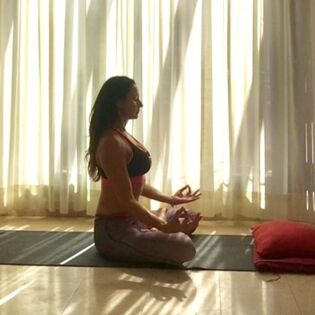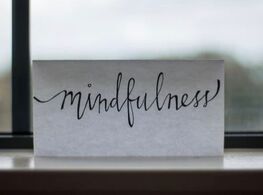Meditation is the process of bringing the mind and body to a place where it rests quietly.
Your busy thoughts settle and fade into the background so there is simply a sense of being present in the moment: awake but also at peace. Meditation can appear difficult, when it can in fact be as simple as “Sit and Be” (Buddha Maitreya) and it is something that can be practiced by anyone.
It may sound like a simple idea, but you may need a little guidance to help you get the benefits of meditation practice. If you have tried to meditate previously and keep losing the focus because of ideas that jump into your head whilst you are trying to be quite you will know it is not as easy as it sounds. That is not to say you cannot do it, you maybe just need a little guidance. I offer an online guided meditation class each week to help you with the techniques and details of the class and times are on the “Online classes” page.
Your busy thoughts settle and fade into the background so there is simply a sense of being present in the moment: awake but also at peace. Meditation can appear difficult, when it can in fact be as simple as “Sit and Be” (Buddha Maitreya) and it is something that can be practiced by anyone.
It may sound like a simple idea, but you may need a little guidance to help you get the benefits of meditation practice. If you have tried to meditate previously and keep losing the focus because of ideas that jump into your head whilst you are trying to be quite you will know it is not as easy as it sounds. That is not to say you cannot do it, you maybe just need a little guidance. I offer an online guided meditation class each week to help you with the techniques and details of the class and times are on the “Online classes” page.
|
Learning to meditate will take a little patience and practice, as with any valuable skill time spent on practice makes it look easy to the newcomer.
A few minutes of meditation can help you to let go of whatever is bothering you and find some rest from troubled thoughts and unwelcome emotions, thereby enhancing your quality of life and increasing your capacity to deal with any day-to-day challenges. For example, a few deep breaths before going into a meeting can just have a calming effect and help reduce any nervousness and stress you have been putting yourself under. Stepping back, relaxing, and taking a wider viewpoint helps you to think more clearly, avoid excessive emotional involvement and develop a greater ability to see the other persons point of view. |
You can meditate with the eyes open or closed it does not matter, but when starting out it can help to have them closed as it reduces the visual stimulation. You are alert, and the mind is fully present in the moment. This is not a trance where you are forcing focus on only one thing.
As an example, here is a 3-minute breathing space meditation, it can fit in easily between other things in your life and it just gives you a little space to let go before picking up any new task.
As an example, here is a 3-minute breathing space meditation, it can fit in easily between other things in your life and it just gives you a little space to let go before picking up any new task.
|
The most effective meditation techniques tend to have one thing in common: they give the mind one thing to do, thereby reducing the usual stream of thoughts. When you become practiced at doing this and the mind is focussed, and calm, and you just rest in the moment, you can experience the silence, stillness, and peace, which is all that remains when there is no internal or external activity to disturb it. There are several meditational practices which involve paying attention to the breath.
|
Some techniques involve being aware of the air entering and leaving the body and observing its natural rhythm without interference or straining. Whilst others are built on Yoga postures and Qigong movements. The main point is to be in the moment so you can observe the sensations as they appear. You do not have to have any particular fixed posture to meditate you just need to remain comfortable and relaxed so that you can enjoy the benefit of a little quietness and calmness.
There are other ways to meditate such as mindful walking or eating, reciting mantras, or listening to music, all benefit and help to bring yourself into the present moment, without the constant churning of the mind worrying about past or future situations you can begin to feel more at peace, calmer, healthier and happier.
Where and when to meditate. Obviously, this will depend on where you are and what is going on in your life. You might be lucky enough to have a quiet space where you can go, whilst at other times you have to fit it in with life around you. The surroundings are not that important, particularly if you are doing an eyes-closed meditation.
There are other ways to meditate such as mindful walking or eating, reciting mantras, or listening to music, all benefit and help to bring yourself into the present moment, without the constant churning of the mind worrying about past or future situations you can begin to feel more at peace, calmer, healthier and happier.
Where and when to meditate. Obviously, this will depend on where you are and what is going on in your life. You might be lucky enough to have a quiet space where you can go, whilst at other times you have to fit it in with life around you. The surroundings are not that important, particularly if you are doing an eyes-closed meditation.
|
The position you choose is whatever position you feel the most comfortable in. Sitting on a straight-backed chair at a height which allows your feet to touch the floor is ideal, as is sitting on the floor in the traditional cross-legged position or with your legs out in a V shape. The idea is to be stable and upright, with your head in line with your back. Laying down is not ideal as you may fall asleep, which is not the objective of the meditation.
|
If you do become uncomfortable, change your position, it is not a test of endurance as that will only make being relaxed all that much harder. As to when to meditate, some people prefer sunrise or sunset, or a certain time each day, it really depends on when you get some free time. Do not stress over it just enjoy the sensations when you get the opportunity.
In the beginning you may be only able to meditate for a few minutes, but with some guidance and practice you can build this up to slightly longer periods of time. Bringing the mind to rest allowing you time to relax is the goal.
Why not try your first meditation class with me for free, get in contact using the “Contact me” form and I will send you the Zoom video class link. Then if you enjoyed it why not subscribe and get access to the other classes.
In the beginning you may be only able to meditate for a few minutes, but with some guidance and practice you can build this up to slightly longer periods of time. Bringing the mind to rest allowing you time to relax is the goal.
Why not try your first meditation class with me for free, get in contact using the “Contact me” form and I will send you the Zoom video class link. Then if you enjoyed it why not subscribe and get access to the other classes.
Mindfulness is simply being fully present in the moment.
I will have a range of guided mindfulness exercises for you to use in the “Members Area”.
You do not have to be religious to be mindful, as we can all experience for ourselves the impact of mindfulness in our daily practices. If you practice a balanced living in your daily lives you will gain many benefits. We after all share the same planet and you are a small part of the total, but you can influence your own part of it. By becoming calm you will find it easier to concentrate, and you experience the here and now in a much broader sense through the improved power of observation.
You will also be better able to cope with life’s frustrations, as an unsettled mind struggles to see things clearly. Sometimes you might feel the world is dumping on you, and so this is the ideal opportunity to step back and consider what is causing this. Mindfulness teaches you to listen to not just the words but the feelings behind them as it may not always seem to be what it appears on the surface. It helps us to relax and let go of the unwanted.
Here are a couple of things you may be doing but do not recognise them, as they are normal for you.
Do you grab the phone the moment it rings, or when a message comes through? Even if you are doing something else at the time.
Do you flit from one task to another without finishing the first one? This just means that it remains on your mind and you must go back to it, it is better to finish it first then it is done.
Take your time in doing the job to the best of your ability in the time required, not just rush it. A little planning beforehand can pay you back greatly as you become mindful of the task and its goal.
In fact, are you always on, in other words do you never switch off and give yourself a few minutes to look at what is going on around you?
If this sounds like your life, then practicing a little mindfulness will definitely bring you benefits not just to the chaos around you but to your health and wellbeing. One of the first ways to be mindful in your life is just to think about your breathing, it is after all with you all the time and sometimes you will breathe deeply and others shallow, it depends on the task in hand. The practice of sitting still and listening to the breath is a good place to start so why not just review the 3-minute guided breathing space meditation earlier on this page.
I will have a range of guided mindfulness exercises for you to use in the “Members Area”.
You do not have to be religious to be mindful, as we can all experience for ourselves the impact of mindfulness in our daily practices. If you practice a balanced living in your daily lives you will gain many benefits. We after all share the same planet and you are a small part of the total, but you can influence your own part of it. By becoming calm you will find it easier to concentrate, and you experience the here and now in a much broader sense through the improved power of observation.
You will also be better able to cope with life’s frustrations, as an unsettled mind struggles to see things clearly. Sometimes you might feel the world is dumping on you, and so this is the ideal opportunity to step back and consider what is causing this. Mindfulness teaches you to listen to not just the words but the feelings behind them as it may not always seem to be what it appears on the surface. It helps us to relax and let go of the unwanted.
Here are a couple of things you may be doing but do not recognise them, as they are normal for you.
Do you grab the phone the moment it rings, or when a message comes through? Even if you are doing something else at the time.
Do you flit from one task to another without finishing the first one? This just means that it remains on your mind and you must go back to it, it is better to finish it first then it is done.
Take your time in doing the job to the best of your ability in the time required, not just rush it. A little planning beforehand can pay you back greatly as you become mindful of the task and its goal.
In fact, are you always on, in other words do you never switch off and give yourself a few minutes to look at what is going on around you?
If this sounds like your life, then practicing a little mindfulness will definitely bring you benefits not just to the chaos around you but to your health and wellbeing. One of the first ways to be mindful in your life is just to think about your breathing, it is after all with you all the time and sometimes you will breathe deeply and others shallow, it depends on the task in hand. The practice of sitting still and listening to the breath is a good place to start so why not just review the 3-minute guided breathing space meditation earlier on this page.
The 5 energies.
Energy of harmony.
This energy gives you a sense of peace throughout your whole being when you feel at ease and comfortable within your surroundings. There is a calmness in the outlook and a fullness to life, and you find a natural equilibrium and balance with all your senses. A person in this state with mindfulness and wisdom will notice a disturbance and recognise that it is only temporary.
Energy of attraction.
This can be as simple as an idea that you are drawn to, or a material object that you feel compelled to get. Such compulsions can deplete your energy and can upset your mindful living. If you stop just long enough to recognise it then you can do something about it. It may be as simple as do I need it? Am I going to use it and is it essential? The gathering of material things for the sake of it just ties you to those things, that is not to say that you should not have nice things around you if they give you pleasure, just thinks about it first.
Energy of aversion.
You may wish to think about this one and make a list of what it means to you. Many of us find fault around us or within believing that the cause of our aversion lies in the object or person involved. This is a negative energy, and it seems to go unchallenged in our minds. If you bring mindfulness to your perceptions it may reveal that a latent, unresolved aversion is born in the past has become an impression, and this can be something as simple as something you have read or heard. This can be seen regularly in social media and is something that you maybe should question before making judgement.
Energy to initiate action.
In the first three energies we observe how they influence our inner lives. This energy is the energy of action. We can image that our daily commitments are a pressure, and if we learn to appreciate them, we can relax and start to recognise our responsibilities. For example, driving the kids to school should not be a chore and a fight to get them to do what you want on your time schedule, why not take the opportunity of being together to just be with them, there is nothing else you can do at the time so do not fight it. The phone and work will still be there after you drop the kids off.
This action flows best when there is no resistance to the task, or fixed dependency on the outcome.
An intention, action and result require a focused energy. Meditation helps to ground us in the present and to conserve energy.
Energy through contact.
This is the energy you get when you experience something pleasurable. It can be the joy of meeting a friend or seeing something that brightens up your day for instance. It can be enough to shake off tiredness and give you that little boost. Equally a painful emotional experience can have a negative impact on you physically.
It is not always possible to live a life in a stable routine. Some days will be more difficult that others, this can be due to external influences beyond your control, that is when you need to recognise them and deal with the most pressing ones first. You can only deal with the present, there is no point in stressing about the past as you cannot change it, likewise the future is yet to happen. Yes, you can make plans for it, but they could be disrupted due to external influences. Try to focus your energies on the present as this is something you can deal with in the here and now.
Mindfulness practice in your life keeps you in contact with the flow of energy of all life.
I offer not just a range of physical exercises that help strengthen the body, but also help maintain flexibility and stability. These attributes are far more essential in your older years, as we all start to slow down, and things take just that little bit longer.
A lot of Eastern countries look at the holistic health of the person and not just the current condition, by taking an overview of what lifestyle you are living you can see what is possibly causing the current issue. Overeating, high salt and sugar for instance can have a dramatic effect on the internal organs of the body, they can also have an effect on your self-esteem and emotional wellbeing.
A lot of Eastern countries look at the holistic health of the person and not just the current condition, by taking an overview of what lifestyle you are living you can see what is possibly causing the current issue. Overeating, high salt and sugar for instance can have a dramatic effect on the internal organs of the body, they can also have an effect on your self-esteem and emotional wellbeing.
Just contact me for bespoke, self-healing treatment plans that can include:
- Acupressure points and reflex points.
- Meditation and relaxation techniques.
- Dietary advice.
|
Registrations:
Insurance: Qualifications: |
Data Protection/Privacy notice
:rebecca_wellness_data_protection_11_2020.pdf Cancellation Policy/Refunds: |







